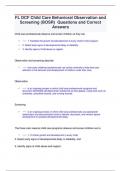FL DCF Child Care Behavioral Observation and
Screening (BOSR) Questions and Correct
Answers
Child care professionals observe and screen children so they can
✓ ~~~ 1. Facilitate the growth and development of every child in their program,
✓ 2. Detect early signs of developmental delay or disability,
✓ 3. Identify signs of child abuse or neglect.
Observation and screening describe
✓ ~~~ how early childhood professionals use certain methods to help them pay
attention to the behavior and development of children under their care.
Observation
✓ ~~~ is an ongoing process in which child care professionals recognize and
document identifiable developmental milestones as they appear, using tools such as
checklists, anecdotal records, and running records.
Screening
✓ ~~~ is an ongoing process in which child care professionals use specialized
observation and documentation tools to identify, document, and monitor typical
development or possible developmental delay.
The three main reasons child care programs observe and screen children are to
✓ ~~~ 1. To foster growth and development in every child,
2. Detect early signs of developmental delay or disability, and
3. Identify signs of child abuse and neglect.
,These processes are also used to support
✓ ~~~ -quality curriculum development;
-help parents support growth and development at home; -allow timely referral for
early intervention services; and -provide a common reference point and basis for
interaction between parents, program staff, and other professionals.
Observation and screening foster growth and development in every child by
✓ ~~~ determining the child's developmental-age level and by using the information
obtained from observation and screening to develop inside and outside learning
spaces, personal care routines, communication and interaction practices, learning
activities, and program policies and procedures.
Observation and screening can detect early signs of developmental delay or
disability when
✓ ~~~ child care staff members are trained to identify and document signs of typical or
atypical growth and development. Since staff members see children throughout the
day and have training in child growth and development, they may be in the best
position to spot the earliest signs of atypical development. Therefore, staff may be in
the best position to help the child and family.
Child care personnel should not
✓ ~~~ attempt to diagnose delay or disability. Instead, they should document typical
and atypical patterns of development and take appropriate action as defined by their
program's written policies and procedures.
Observation and screening can help child care professionals identify the signs of
child abuse and neglect by
, ✓ ~~~ reporting any suspected abuse or neglect and can do so anonymously.
However, people who work with children are required by law to identify themselves
when they report suspected child abuse or neglect. Failure to report suspected
abuse or neglect is a felony of the third degree in Florida.
Observation and screening support quality curriculum development by
✓ ~~~ focusing learning goals and objectives, lesson plans, and teaching strategies
on the development and implementation of activities that strengthen the child's skills.
The best child care professionals can recognize what each child knows and can do,
and uses this information to help increase skills, abilities, and knowledge.
Observation and screening can help parents support their child's growth and
development at home by
✓ ~~~ increasing the volume and quality of information available to them. When
quality information is combined with the professional services provided by a child
care program, a child's outcomes improve, both at the program and at home.
Observation and screening allow
✓ ~~~ timely referral for intervention. The earlier signs of developmental delay or
disability are identified, the better the outcome for the child.
The American Academy of Pediatrics recommends
✓ ~~~ that all children be screened for developmental delays and disabilities during
regular well-child doctor visits at 9 months, 18 months, and 24 or 30 months.
However, observation of a child can begin at birth.
Observation and screening provide an opportunity for communication between
parents, staff, and child development specialists because
✓ ~~~ they include written evidence of a child's growth and development over time.
, Written records collected by a child care professional can be
✓ ~~~ critical to a team of people who are helping a child with developmental delay or
disability.
Child care programs observe and screen children because these processes support
✓ ~~~ quality curriculum development; help parents support growth and development
at home; allow timely referral for early intervention services; and provide a common
reference point and basis for interaction between parents, program staff, and other
professionals.
During an observation session, a trained adult
✓ ~~~ monitors a child as he or she demonstrates identified skills or abilities within a
developmental domain. For example, a staff member observing children's growth
and development in the Physical Development domain may document an infant's
ability to roll over, a toddler's ability to walk, a preschooler's ability to kick a ball, and
a school-age child's ability to use a swing.
Observation sessions should be performed by
✓ ~~~ a familiar person in the child's natural environment at a time when he or she is
at his or her best.
The goal is to allow the observer to
✓ ~~~ document the child's skills and abilities fairly and objectively.
In a quality program, results are carefully documented following
✓ ~~~ set guidelines and written procedures. Methods of documentation include
checklists, anecdotal records, and running records.
Observation can:




